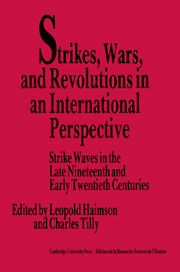 Strikes, Wars, and Revolutions in an International Perspective
Strikes, Wars, and Revolutions in an International Perspective Book contents
- Frontmatter
- Contents
- List of contributors
- Preface
- Part I Introductions
- Part II Models and realities
- Part III Workers in metal-processing enterprises in comparative perspective
- Part IV The effects of short-term variation
- 18 Introduction
- 19 Economic cycles and labor conflicts in Germany during the first quarter of the twentieth century
- 20 The crisis of state and society in Britain, 1917–1922
- 21 Strikes and the war
- 22 Labor unrest in Imperial Russia on the eve of the First World War: the roles of conjunctural phenomena, events, and individual and collective actors
- 23 Strikes in Russia, 1917: the impact of revolution
- Part V Conclusion
19 - Economic cycles and labor conflicts in Germany during the first quarter of the twentieth century
Published online by Cambridge University Press: 25 March 2010
- Frontmatter
- Contents
- List of contributors
- Preface
- Part I Introductions
- Part II Models and realities
- Part III Workers in metal-processing enterprises in comparative perspective
- Part IV The effects of short-term variation
- 18 Introduction
- 19 Economic cycles and labor conflicts in Germany during the first quarter of the twentieth century
- 20 The crisis of state and society in Britain, 1917–1922
- 21 Strikes and the war
- 22 Labor unrest in Imperial Russia on the eve of the First World War: the roles of conjunctural phenomena, events, and individual and collective actors
- 23 Strikes in Russia, 1917: the impact of revolution
- Part V Conclusion
Summary
Germany has never been the classic country for researching labor conflicts and least of all for researching strike action by quantitative methods. Thus, only a few studies on the subject have been published. The time that has been best studied in the context of economic cycles and labor conflicts is the period before 1914. The findings fit well into the international context, for they confirm the impressive dependence of strike frequencies on economic cycles. A closer look, however, shows some problems in interpreting the results. These problems have to do with the choice of comparative indicators.
First of all, with regard to strike indicators, the fact that they oscillate between greater extremes than the series of economic cycle indicators is of importance. Thus, it is not a comparison of absolute figures that is required but one of the relative decline and increase, that is, a study of their relative changes.
Further, it is significant that positive results only arise if the number of strikes (and lockouts) is compared with economic cycle indicators, rather than the number of people involved. Therefore, Perrot's observation on France applies here: The economic cycle is the strongest influence on the decision to take strike action but all other questions, such as the form of participation, organization, duration, regional and branch involvement, depend on national or other factors. This statement becomes even more important because it is apparently valid regardless of trade union influence on a strike. Also, it applies especially to those times that were still characterized by very weak union movements (France and Germany before 1885).
- Type
- Chapter
- Information
- Strikes, Wars, and Revolutions in an International PerspectiveStrike Waves in the Late Nineteenth and Early Twentieth Centuries, pp. 449 - 456Publisher: Cambridge University PressPrint publication year: 1989


